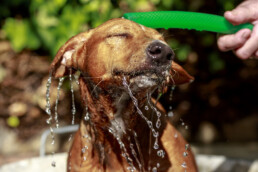How to protect your dog from heat stroke
As the warm summer weather approaches, it's important to remember that dogs are vulnerable to heat related injuries, the most dangerous of which is heat stroke, which can often prove fatal.
Heat stoke and heat exhaustion are dangerous conditions for any dog and should be avoided at all costs. Heat stroke occurs when the dog's normal body mechanisms are unable to keep body temperature within a safe range. A dog's normal body temperature is 100-102.5 degrees. A body temperature over 106 degrees is deadly.
Heat Exhaustion
Heat exhaustion, the early stages of heat stroke, occurs when the dog begins overheating. To remedy the effects of heat exhaustion, you must take immediate action to reduce the dog's body temperate and prevent the danger of heat stroke. Symptoms of heat exhaustion include diarrhea, nausea and vomiting, rapid panting, and the skin inside the ears reddening. Should you notice any of these symptoms and suspect your dog might be suffering from heat exhaustion, take immediate action by bringing your dog indoors to a cooler environment immediately, near a fan if you have one, offer some fresh water, and dampen the dampen the skin with lukewarm water and allow it to air-dry.
Heat Stroke
Signs of heat stroke include rapid panting, a bright red tongue, red or pale gums, and thick, sticky saliva. The dog may also show signs of weakness, dizziness and vomiting.
If you suspect your dog is suffering from heat stroke, remove them from the hot enviroment immediately. Wet them thoroughly with room-temperature water (do not use not ice or very cold water, as it will trigger other life-threatening conditions), and increase the flow of cool air around them with a fan.
Five Ways to Prevent Heat Stoke
So, here are five things to remember when the temperature gets high in the summer months:
- Don’t let your dog linger on hot surfaces like asphalt and cement. Being so close to the ground can heat their body quickly and can also lead to burns on sensitive paw pads. Keep walks to a minimum.
- Provide access to fresh water at all times. Make sure an outside dog has access to shade and plenty of cool water.
- Restrict exercise when temperatures soar, and do not muzzle the dog because it inhibits their ability to pant.
- Many dogs enjoy a swim, splashing in a pool, or running through a sprinkler in warmer weather can help bring body temperatures down.
- Never leave your pet in a parked car, not even if you park in the shade or plan to be gone for only a few minutes. The temperature inside of a car can reach oven-like temperatures in just minutes, often in excess of 140 degrees. That quick errand to the shops can very quickly turn into a disaster and could be fatal for your pet.
The last point is particularly important to remember. The number of times I have seen a dog left alone in a parked car at the supermarket during the warmer summer months is horrifying. If you know you have to stop by the supermarket to pick up a few groceries, please leave your dog at home. Your dog will thank you for it!
Remember: Any dog that cannot cool itself off is at risk from heat stroke!

